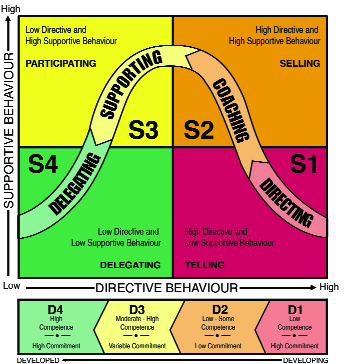
Features
Leadership
Leadership: The four stages of fundamental leadership
There are four leadership styles that can be used when managing a team; each leadership style corresponds to one of the four stages of team development. This theory of leadership is often referred to as situational leadership. In situational leadership, each leader management style is based on the degree of direction and support the team requires at each stage.
December 11, 2007
By Barry Bouwsema
 There are four leadership styles that can be used when managing a team; each leadership style corresponds to one of the four stages of team development. This theory of leadership is often referred to as situational leadership. In situational leadership, each leader management style is based on the degree of direction and support the team requires at each stage. A leader must adjust his or her style to provide what the team cannot provide for itself at this stage. The key goal of the leader is to move the team through the stages of the team development until they reach the stage where they can perform independently. If a setback occurs at any stage in this leadership model, the leader must revert to the previous leadership style to assist the team in resolving the problem.
There are four leadership styles that can be used when managing a team; each leadership style corresponds to one of the four stages of team development. This theory of leadership is often referred to as situational leadership. In situational leadership, each leader management style is based on the degree of direction and support the team requires at each stage. A leader must adjust his or her style to provide what the team cannot provide for itself at this stage. The key goal of the leader is to move the team through the stages of the team development until they reach the stage where they can perform independently. If a setback occurs at any stage in this leadership model, the leader must revert to the previous leadership style to assist the team in resolving the problem.
When using situational leadership, it is useful to keep in mind that there is no “one best way” to influence others. Rather,
any leader behaviour may be more or less effective depending on the “readiness” of the person the leader is attempting to influence.
Factors that affect situational decisions include motivation and capability of followers. This, in turn, is affected by factors within the particular situation. The relationship between followers and the leader is another factor that affects leader behaviour as much as it does follower behaviour, as trust is a key concept in the leader–follower relationship.
The diagram below depicts the amount of support and direction that the leader should give to the worker at each stage, depending on the worker’s level of competence.
Utilizing this situational leadership diagram, in quadrant S1 (telling) the fire officer makes the decisions and provides clear and specific instruction. If subordinates are either unable or unwilling to perform a task, specific direction and close supervision are needed. The worker has a low level of competence at this point but a high level of commitment or desire (D1). The fire officer must tell the firefighter what to do and where to perform the various tasks. An example of this leadership style would be the careful monitoring of the probationary firefighter who has yet to develop the needed skills to function independently.
In quadrant S2 (selling) a coaching leadership style is effective when the subordinates are willing, but somewhat unable to carry out their task (D2) due to lack of confidence or lack of skill development. This coaching style provides both task and relationship leader behaviours. This style is most effective with subordinates who are still unable to perform the task, but are eager to do it; this situation occurs with junior-ranked firefighters who have a base knowledge, but require more experience and time-on-task. This style encourages some two-way communication between the officer and firefighter which will help the firefighter build his or her confidence related to performing that task. Constructive feedback encourages growth at this point.
In quadrant S3 (participating) a supporting style of leadership works best when fire crews perform the required tasks. This moderate level of follower supportive behaviour requires the leader to maintain two-way communication and to encourage and support the skills the followers have developed. The firefighter has a moderate level of competence at this point with a varying level of commitment (D3). The fire officer works primarily along side the crews as a participant as opposed to the supervisor when applying this leadership style. The mentoring of a new officer by a veteran officer is a prime example of this leadership style.
Finally, in quadrant 4 (delegating) the firefighters are able, willing and confident to perform their tasks. A delegating style involves few leader task or relationship behaviours because subordinates are empowered to make decisions. They decide how and when to do things based on minimum input from the fire officer. A fire crew led by a seasoned veteran needs little supervision from the officer as the task is completed by firefighters who are motivated and competent (D4).
At each step of the situational leadership model, communication is crucial. Another key concept when applying this leadership model is to properly identify which stage of readiness the follower is presently exhibiting. Utilizing the incorrect leadership styles, such as allowing a rookie firefighter too much freedom or supervising a senior firefighter too closely, will create a problem situation. Fire officers should be able to apply all four leadership styles and adjust their approach to leadership depending on the readiness of the firefighter.
References:
Clemmer, J. (2003). The Leader’s Digest. Toronto: TCG Press.
Situational Leadership. Retrieved Nov. 20, 2006, from www.situational.com .

Barry Bouwsema is a 20-year veteran with the fire service and works as a company officer/paramedic for Strathcona County Emergency Services in Sherwood Park, Alta.
Print this page